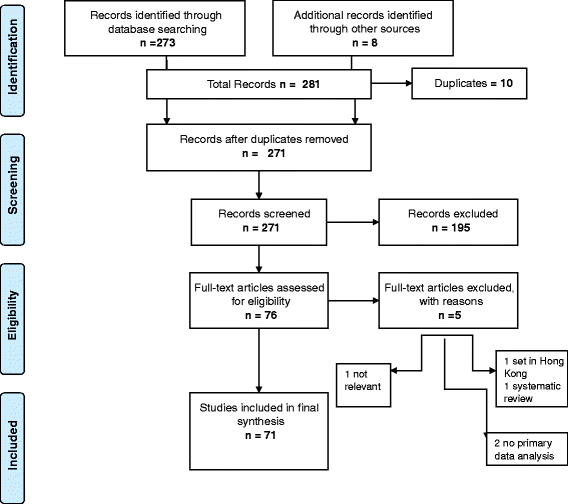Eating soup with nails of pig: thematic synthesis of the qualitative literature on cultural practices and beliefs influencing perinatal nutrition in low and middle income countries
- PMID: 27464710
- PMCID: PMC4964025
- DOI: 10.1186/s12884-016-0991-z
Eating soup with nails of pig: thematic synthesis of the qualitative literature on cultural practices and beliefs influencing perinatal nutrition in low and middle income countries
Abstract
Background: The perinatal period, i.e. pregnancy, childbirth and early infancy, is a significant transition period where the biological and the social strongly intersect. In low and middle-income countries the disease burden arising from the perinatal period, is still substantial. The perinatal period is also a crucial window of opportunity for reducing undernutrition and its long term adverse effects.
Methods: We explored qualitative research conducted in low resource settings around the perinatal continuum over the past two decades, with a particular focus on the 'cultural' realm, to identify common themes influencing maternal and infant nutrition. We systematically searched electronic databases from 1990 to 2014, including MEDLINE, EMBASE, PsycINFO, Scopus and Cumulative Index to Nursing and Allied Health Literature, using relevant search terms including traditional beliefs, practices, pregnancy, childbirth, developing countries etc. Adapted Consolidated Criteria for Reporting Qualitative Health Research and Critical Appraisal Skills Programme criteria were used to determine quality of studies. We synthesised the literature thematically, enabled by NVivo 10 software.
Results: Most studies showed cultural support for breastfeeding, although most traditional societies delayed breastfeeding due to colostrum being considered 'dirty'. A range of restrictive practices through pregnancy and the post- partum period were revealed in Asia, Latin America and Africa. There was a strong cultural understanding of the healing power of everyday foods. A wide range of good foods and bad foods continued to have currency through the perinatal continuum, with little consensus between groups of what was beneficial versus harmful. Cross-cutting themes that emerged were 1) the role of the woman/mother/wife as strong and good; 2) poverty restricting women's nutrition choices; 3) change being constant, but the direction of change unpredictable.
Conclusions: A rich and diverse repertoire of cultural practices and beliefs influenced perinatal nutrition. Results from this synthesis should influence public health policymakers and practitioners, to tailor contextually specific, culturally responsive perinatal nutrition interventions to optimise health and wellbeing of mother-infant dyads. Ideally these interventions should build on culturally sanctioned life affirming behaviours such as breastfeeding, promoting post-partum rest and recovery, while modifying the potentially harmful aspects of other cultural practices in the perinatal period.
Keywords: Breastfeeding; Culture; Low and middle-income countries; Maternal and child nutrition; Maternal health; Qualitative research; Synthesis; Traditional practices.
Figures
Similar articles
-
How natural is the supernatural? Synthesis of the qualitative literature from low and middle income countries on cultural practices and traditional beliefs influencing the perinatal period.Midwifery. 2016 Aug;39:87-97. doi: 10.1016/j.midw.2016.05.005. Epub 2016 May 10. Midwifery. 2016. PMID: 27321725 Review.
-
Exploring cultural influences in perinatal and early childhood nutrition.Rev Salud Publica (Bogota). 2024 May 1;26(3):115569. doi: 10.15446/rsap.V26n3.115569. eCollection 2024 Jun. Rev Salud Publica (Bogota). 2024. PMID: 40098945 Free PMC article. Review.
-
Dirty and 40 days in the wilderness: Eliciting childbirth and postnatal cultural practices and beliefs in Nepal.BMC Pregnancy Childbirth. 2016 Jul 5;16(1):147. doi: 10.1186/s12884-016-0938-4. BMC Pregnancy Childbirth. 2016. PMID: 27381177 Free PMC article. Review.
-
"Nothing special, everything is maamuli": socio-cultural and family practices influencing the perinatal period in urban India.PLoS One. 2014 Nov 4;9(11):e111900. doi: 10.1371/journal.pone.0111900. eCollection 2014. PLoS One. 2014. PMID: 25369447 Free PMC article.
-
Breastfeeding and weaning practices in rural Mexico.Nutr Health. 1994;9(4):255-63. doi: 10.1177/026010609400900402. Nutr Health. 1994. PMID: 8065664
Cited by
-
Current trends in household food insecurity, dietary diversity, and stunting among children under five in Asia: a systematic review.J Glob Health. 2025 Jan 17;15:04049. doi: 10.7189/jogh.15.04049. J Glob Health. 2025. PMID: 39819648 Free PMC article.
-
Community perspectives on maternal and child health during nutrition and economic transition in sub-Saharan Africa.Public Health Nutr. 2021 Aug;24(12):3710-3718. doi: 10.1017/S1368980020003018. Epub 2020 Sep 15. Public Health Nutr. 2021. PMID: 32928324 Free PMC article.
-
'Because the baby asks for it': a mixed-methods study on local perceptions toward nutrition during pregnancy among marginalised migrant women along the Myanmar-Thailand border.Glob Health Action. 2018;11(1):1473104. doi: 10.1080/16549716.2018.1473104. Glob Health Action. 2018. PMID: 29785874 Free PMC article.
-
Psychosocial barriers and enablers of exclusive breastfeeding: lived experiences of mothers in low-income townships, North West Province, South Africa.Int Breastfeed J. 2020 Aug 26;15(1):76. doi: 10.1186/s13006-020-00320-w. Int Breastfeed J. 2020. PMID: 32847591 Free PMC article.
-
Psychosocial Experiences Related to Dietary Behavior of Japanese Lactating Women: A Qualitative Study.Nutrients. 2023 Feb 3;15(3):789. doi: 10.3390/nu15030789. Nutrients. 2023. PMID: 36771501 Free PMC article.
References
-
- Murray CJL, Vos T, Lozano R, Naghavi M, Flaxman AD, Michaud C, Ezzati M, Shibuya K, Salomon JA, Abdalla S, et al. Disability-adjusted life years (DALYs) for 291 diseases and injuries in 21 regions, 1990–2010: a systematic analysis for the Global Burden of Disease Study 2010. Lancet. 2012;380(9859):2197–223. doi: 10.1016/S0140-6736(12)61689-4. - DOI - PubMed
Publication types
MeSH terms
LinkOut - more resources
Full Text Sources
Other Literature Sources
Medical
Research Materials
Miscellaneous


